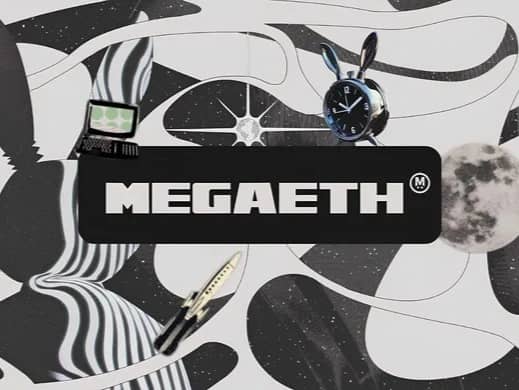订阅 wiki
Share wiki
Bookmark
MegaETH
MegaETH
MegaETH 是一个 以太坊 Layer 2 (L2) 区块链,旨在实现高交易速度和低延迟。它旨在利用极端的节点专业化,消除区块 gas 限制,并为开发者解锁连续计算 [1] [2]。
概述
MegaETH 正在开发成为一种高性能的 以太坊 Layer 2 解决方案,专注于实现比许多现有区块链更快的交易处理速度和更低的区块时间 [3]。
该项目最初由 Yilong Li 于 2022 年构思,并在 2024 年中期在初步筹款后开始开发 [3]。其核心目标是创建一个“实时区块链”,能够支持需要高吞吐量和响应速度的去中心化应用程序 (DApps),例如 DeFi、GameFi 和 SocialFi 中的应用程序 [4]。
该项目旨在实现超过每秒 100,000 笔交易 (TPS) 的交易处理速度和低于 10 毫秒的区块时间 [3] [1]。这一性能目标涉及与一些其他 L2 不同的设计决策,尤其是在某些组件(如排序器)的去中心化方面 [5]。MegaETH 利用 EigenDA 进行数据可用性,利用 EigenLayer restaking 来保证安全 [5]。
历史
MegaETH 最初由计算机科学家 Yilong Li 于 2022 年构思 [3] [5]。这个想法受到了关于扩展区块链和利用数据可用性层的讨论的影响 [5]。在成功完成初步筹款后,区块链的开发于 2024 年中期开始 [3]。
主要里程碑包括:
- 2022 年:项目由 Yilong Li 构思 [3]。
- 2024 年中期:在种子轮融资后开始开发 [3]。
- 2024 年 6 月 27 日:在种子轮融资中筹集了 2000 万美元 [3]。
- 2024 年 11 月 20 日:参加了曼谷 Devcon 的世界计算机日活动 [6]。
- 2024 年 12 月 13 日:筹集了 1000 万美元 [3]。
- 2025 年 2 月 5 日:宣布推出 “The Fluffe” NFT 系列 [3]。
- 2025 年 2 月 12-13 日:“The Fluffe” NFT 的第一阶段铸造活动举行 [3]。
- 2025 年 3 月 25 日:宣布努力消除区块 gas 限制 [6]。
- 2025 年 3 月 26 日:Bitget 钱包宣布原生支持 MegaETH 测试网 [4]。
- 2025 年 4 月 22 日:MegaMafia 2.0 加速器计划开放申请 [6] [7]。
技术和性能
MegaETH 被设计为与 EVM 兼容的 Layer 2 网络,允许现有的 以太坊 应用程序潜在地移植过来 [5]。其主要重点是实现高性能指标。
关键技术方面和性能目标包括:
- 交易处理速度 (TPS):目标是超过 100,000 TPS [3] [1]。据报道,私人测试达到了 15,000 TPS [5]。
- 区块时间:目标是低于 10 毫秒的区块时间,目标是达到 1 毫秒以实现“实时”性能 [3] [1]。
- Gas 容量:目标是超过每秒 10 gigagas [1]。私人测试显示使用了 1.5 gigagas,并计划通过专有的并行化引擎将其翻倍 [5]。
- 排序器:使用单个中心化排序器来最大限度地减少延迟并最大限度地提高吞吐量 [5]。排序器发布抵押品,如果它恶意行事,可以被削减,并且计划使用备份排序器 [5]。
- 数据可用性 (DA):外包给 EigenDA,后者由 EigenLayer restaking 提供支持 [5]。与直接将数据发布到 以太坊 blobs 相比,这允许更高的带宽 [5]。
- 网络结构:包括一个完整的节点网络,这些节点根据排序器更新其状态,一个用于有效性检查的证明者网络,以及接收状态差异(diffs)以使用较低的硬件要求更新其状态的副本节点 [8]。
资金和投资者
MegaETH 已经进行了多轮融资,以支持其发展。
- 种子轮:于 2024 年 6 月 27 日筹集了 2000 万美元 [3]。著名的投资者包括 Dragonfly Capital、Vitalik Buterin 和天使投资人 Santiago R. Santos [3] [5]。其他参与者包括 Figment Capital 和 Robot Ventures [5]。ABCDE Capital 也被列为投资者 [9] [10]。
- 额外资金:于 2024 年 12 月 13 日通过 Cobie 的 Echo 平台筹集了另外 1000 万美元 [3] [5]。
- NFT 销售:计划通过销售 “The Fluffe” NFT 系列筹集更多 2700 万美元 [3]。此次销售旨在筹集 3000 万美元 [5]。
预计到 2025 年第一季度末,筹集的资金总额约为 5700 万美元 [3]。
The Fluffe NFT 系列
2025 年 2 月 5 日,MegaETH 团队宣布推出 “The Fluffe”,这是一个旗舰灵魂绑定(铸造后不可交易)NFT 系列 [3]。该系列由 10,000 个人形兔子 NFT 组成 [3]。
- 目的:NFT 系列的推出是为了进行公共筹款,并让社区“在游戏中拥有有意义的皮肤” [3]。该团队表示,其目的是避免与积分计划相关的问题,并吸引表现出“信念和承诺”的用户 [3]。
- 铸造详情:铸造仅限白名单 [3]。每个 NFT 的铸造成本为 1 ETH [3]。铸造分两个阶段进行。
- 代币分配:该团队计划将至少 5% 的 MegaETH 代币供应空投给 NFT 持有者 [3]。代币分配旨在随着用户“进化”他们的 NFT 而增加 [3]。
- 设计特点:每个 Fluffe NFT 都有独特的外观,并且属于 16 个阴谋集团之一 [3]。功能包括可定制的化妆品、2D 个人资料图片和“进化”选项 [3]。
生态系统和用例
MegaETH 与 EVM 兼容,允许现有的 DApp 潜在地迁移 [5]。该项目旨在促进新应用程序的开发,这些应用程序利用其高速和吞吐量能力 [5]。
- MegaMafia:一个为在 MegaETH 上构建应用程序的早期创始人提供的加速器计划 [7]。参与者与核心团队和顾问共同构建 [7]。MegaMafia 2.0 的申请于 2025 年 4 月 22 日开放 [6] [7]。该计划包括为期一个月的异地活动,创始人与 Mega 核心团队、顾问和校友共同生活和构建 [7]。申请于 4 月 23 日开放,滚动录取一直持续到 2025 年 6 月 1 日 [7]。决赛选手于 6 月中旬飞往纽约进行面对面面试 [7]。
- 潜在应用:高性能旨在解锁目前在较慢的区块链上不可行的用例 [5]。示例包括高频交易、机构 DeFi 和交互式游戏或流媒体平台 [5]。在 MegaMafia 上下文中提到的项目包括去中心化交易所 (GTE, Valhalla)、游戏化交易 (Euphoria)、带有博彩的直播 (Sweep) 和 3D 世界引擎 (AWE) [5] [7]。
合作伙伴
MegaETH 已经建立了合作伙伴关系,以扩大其影响范围和生态系统。
- Bitget 钱包: 2025 年 3 月 26 日,Bitget 钱包宣布原生集成 MegaETH 测试网 [4]。这允许 Bitget 钱包用户访问 MegaETH 测试网,领取测试代币,与 DApp 交互,并直接在钱包中提供流动性 [4]。这种集成使用户能够在两个团队的激励活动之前探索 MegaETH 不断增长的生态系统 [4]。
团队
发现错误了吗?
